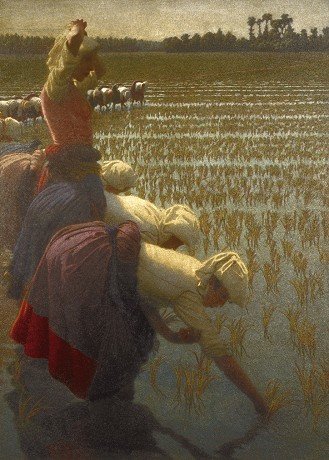Rivoluzione!
dal 25/9/2008 al 10/1/2009
Segnalato da
Giacomo Balla
Umberto Boccioni
Carlo Carra'
Carlo Fornara
Vittore Grubicy de Dragon
Emilio Longoni
Angelo Morbelli
Plinio Nomellini
Giuseppe Pellizza da Volpedo
Gaetano Previati
Luigi Russolo
Giovanni Segantini
Giovanni Sottocornola
Edoardo Berta
Filippo Franzoni
Giovanni Giacometti
Luigi Rossi
Simonetta Fraquelli
Tobia Bezzola
Christopher Riopelle
25/9/2008
Rivoluzione!
Kunsthaus Zurich, Zurich
Italian Modernism from Segantini to Balla

Curated by Simonetta Fraquelli, Tobia Bezzola and Christopher Riopelle
From 26 September 2008 until 11 January 2009, the Kunsthaus Zürich will
offer Switzerland’s first ever comprehensive overview of Divisionism, the
most significant movement in Italian painting in the late 19th century. These
masterpieces of colour and light testify to a world in upheaval – from idyllic
landscapes and the blessings of modern technology, to the hard lot of the
farmer and a burgeoning proletariat.
ITALY’S ANSWER TO FRENCH IMPRESSIONISM
Like Georges Seurat and Paul Signac of the French Neo-Impressionists,
Giovanni Segantini is emblematic of Divisionism, a master of colour,
luminescent power and brilliance. The Divisionists were Italy’s answer to the
Pointillists, who were in turn the Parisian successors to the Impressionists.
Adherents of Divisionism analysed colour and light, and Segantini and his
contemporaries ushered in classical modernism in Italy, applying colour theory
and the principles of optics to the work of painting. Their dots and brushstrokes
often rendered in complementary, contrasting primary colours, the Divisionists
created dazzling compositions flooded with light. Among the first generation of
Divisionist painters were Giovanni Segantini, Giuseppe Pellizza da Volpedo and
Gaetano Previati, who were to become its chief proponents. Their successors in
the second generation, Giacomo Balla, Carlo Carrà and Umberto Boccioni,
turned later in their careers to Futurism.
A POLITICALLY PROGRESSIVE MODE OF EXPRESSION
While the French Post-Impressionists created an idyllic imaginary world, the
Divisionists used their paintings to express a range of progressive socio-political
views, as exemplified by some of the 60 works on show. The exhibition also
features paintings with natural motifs, such as Umberto Boccioni’s ‘Lombard
Landscape’ (1908), and treatments of symbolist topics like ‘The Sound of the
Brook’ (1902) by Emilio Longoni. Angelo Morbelli’s ‘Christmas Among the
Forgotten’ (1903), meanwhile, presents the viewer with the bare interior of a
shelter for the homeless and the lonely souls within, yearning for warmth,
sustenance and affection. Giacomo Balla’s ‘Farmer’ (1903) seems unable to live
in comfort by the sweat of his brow, in an era in which the rural population was
increasingly seeking work and refuge in the cities. And yet, in those cities as
well, hard by the achievements of modern technology, as exemplified in Giacomo
Balla’s celestially glistening ‘Streetlamp’ (1909), a starving class was on the rise too: the proletariat. The twin faces of the industrial revolution, as recognized by
the artists of the period, are everywhere in evidence at the Kunsthaus Zürich:
from Emilio Longoni’s 1894 painting ‘Social Contrasts’ to Segantini’s idyllic
‘Midday in the Alps’ (1891).
AN EXHIBITION FEATURING SWISS ARTISTS
Divisionism also plays a role in Swiss art history, with painters mainly from the
southern part of the country, such as Edoardo Berta, Filippo Franzoni and
Giovanni Giacometti, adopting the stylistic vocabulary of their Italian
counterparts. Their works are distributed throughout the exhibition in rooms
devoted to Landscape, Symbolism, Social Issues, Rural Utopia and Forward into
Futurism. Works on loan from Italian museums as well as from the Musée
d’Orsay in Paris or New York’s Museum of Modern Art are joined by a dozen
rarely shown pieces from private collections. An audioguide, included in the
price of admission, and a film made in Milan in 2008 inform visitors about
Divisionist painting technique, provide biographical data on individual artists, and
sketch in the background to the creation of a whole series of paintings. Guided
tours are available in German, French and Italian.
The exhibition, a co-production with the National Gallery, London, was curated
by Simonetta Fraquelli, Tobia Bezzola and Christopher Riopelle. The catalogue
includes essays by Vivien Greene, Giovanna Ginex, Aurora Scotti Tosini and
Simonetta Fraquelli.
Italian Divisionism
Giacomo Balla, 1871-1958
Umberto Boccioni, 1882-1916
Carlo Carrà, 1881-1966
Carlo Fornara, 1871-1968
Vittore Grubicy de Dragon, 1851-1920
Emilio Longoni, 1859-1932
Angelo Morbelli, 1853-1919
Plinio Nomellini, 1866-1943
Giuseppe Pellizza da Volpedo, 1868-1907
Gaetano Previati, 1852-1920
Luigi Russolo, 1885-1947
Giovanni Segantini, 1858-1899
Giovanni Sottocornola, 1855-1917
Swiss Painters among the Divisionists
Edoardo Berta, 1867-1931
Filippo Franzoni, 1857-1911
Giovanni Giacometti, 1868-1933
Luigi Rossi, 1853-1923
Image: Angelo Morbelli, In the Rice Fields (In risaia), 1898-1901. Oil on canvas, 183 x 130 cm, Private collection
For additional press information, artists’ biographies, lists of works and visual material please contact Kristin Steiner, Kunsthaus Zürich, Press and Communication, kristin.steiner@kunsthaus.ch, +41 (0)44 253 84 13
Kunsthaus Zürich
Heimplatz 1, CH–8001 Zurich
Open
Sat/Sun/Tues 10 a.m.–6 p.m., Wed/Thurs/Fri 10 a.m.–8 p.m.
Christmas: 24 and 26 December 10 a.m.-6 p.m. Closed 25 December
New Year: 1 and 2 January 2009 10 a.m.-6 p.m.
Admission
CHF 18.–/12.– (concessions)/CHF 14.– per head for groups of 20 or more, including audioguide in English and German



